Natural disaster safety way guidance system
ISO/DIS 22578
① ISO/DIS 22578 provides a natural disaster safety way guidance system to guide people in the affected areas to take immediate evacuation actions according to the type of disaster when a disaster occurs.
② In order to guide people to the evacuation sites or shelters when natural disasters occur, it is essential not to make them lose their ways. So, guidance signs must be installed at appropriate intervals and without interruption on the way to the evacuation site.
③ When a disaster occurs at night and the lifeline is interrupted and the normal power supply is lost, how to reach the evacuation site in total darkness is an important issue, so measures against darkness were recommended.
1. Scope
This standard specifies the principles governing the design and application of signs and plans used to create a natural disaster safety way guidance system, which helps people evacuate to safety areas or shelters in case of natural disasters such as landslides, debris flow, steep slopes, tsunamis, tornadoes, floods, large-scale fire, and volcanic eruptions.
2. Purpose of the safety way guidance system
The natural disaster safety way guidance system is necessary to warn people in areas likely to be affected by a disaster when it occurs and help them take safety action quickly according to the type of disaster. The objective of the natural disaster safety way guidance system is to display information about the hazards of possible natural disasters in vulnerable regions, warn the people living in the area that is affected by a disaster when it occurs, and guide them to evacuate quickly.
3. Signs used in natural disaster safety way guidance system
a) Safety signs
The safety sign components of natural disaster safety way guidance signs shall be registered safety signs from ISO 7010. Signs used in natural disaster safety way guidance systems are shown in Table 1.
< Table 1 - Signs used in natural disaster safety way guidance system >
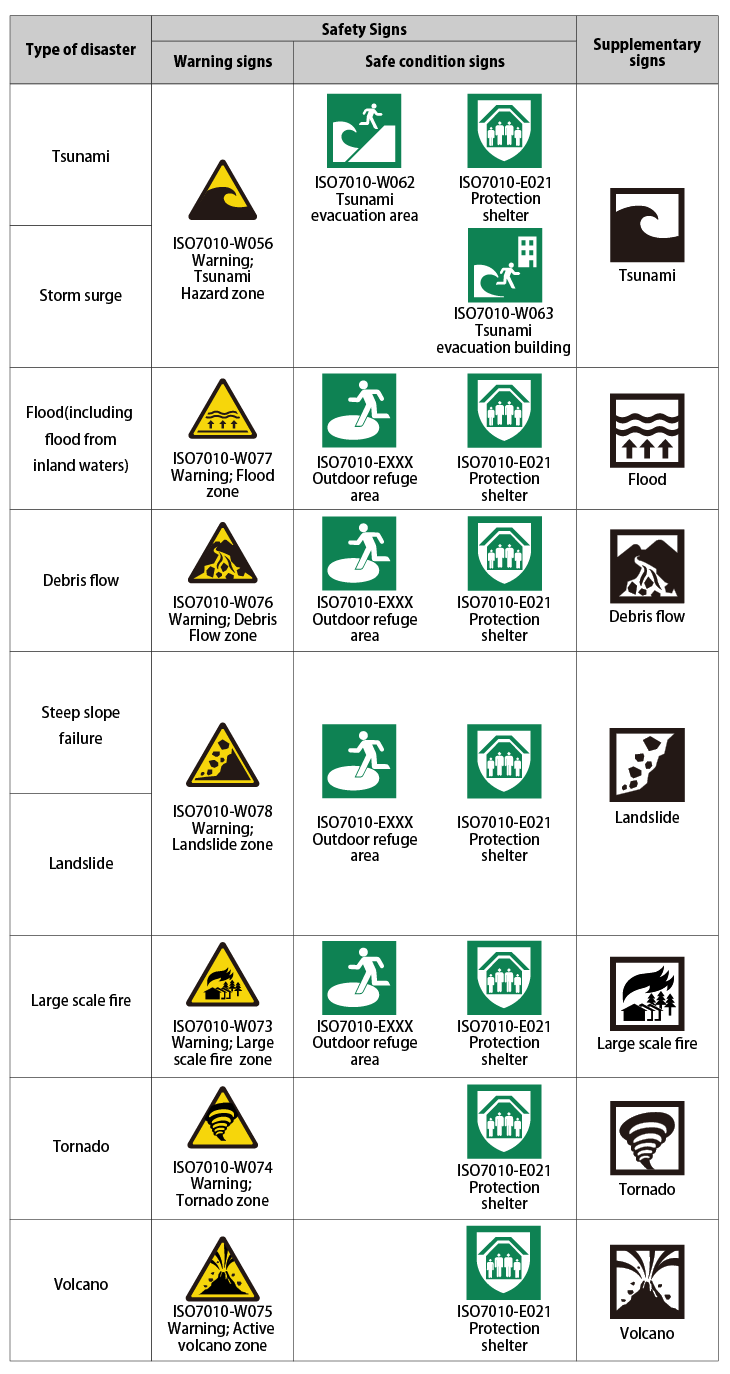
b) Directional supplementary arrow signs
Arrows in direction signs shall be used in conjunction with safety signs to indicate the direction of movement a person should take to reach the indicated destination. The format of the direction arrow shall be arrow type D from ISO 3864-3.
c) Suitability marking
It is necessary to indicate the type of disasters which the places of refuge are appropriate. Place of refuge signs ensure anyone who happens to be visiting and unfamiliar with the area is able to identify their suitability or unsuitability properly. This is because the construction and location for place of refuge may only be appropriate for particular natural disasters.
In the place of refuge signs and evacuation route signs, the appropriate supplementary symbols which are given in Table 1 should be used to indicate the suitable and not suitable natural disasters for that place of refuge.
< Figure 1 Example of suitability marking >
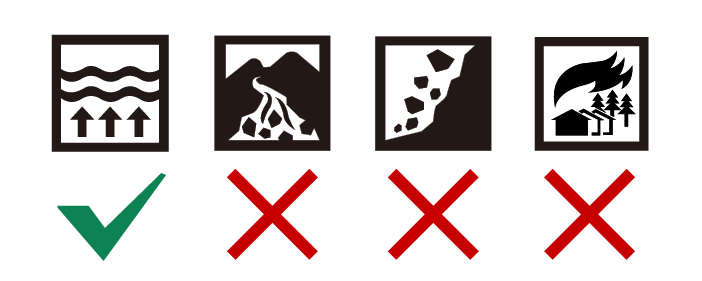
Captions appear above the natural disaster general graphical symbols. Below the symbol, put a “✓” if that evacuation area is suitable, and put an “×” mark if it is not.
This example indicates that the given evacuation area is suitable for floods, but is not suitable for debris flows, Landslides and Large scale fire.
< Figure 2 Example of combination type of evacuation route sign >
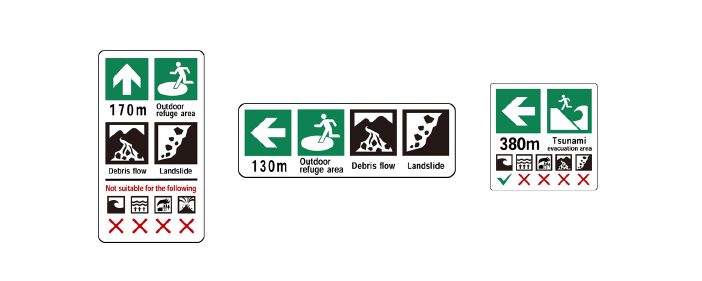
< Figure 3 Example of combination type of place of refuge sign >
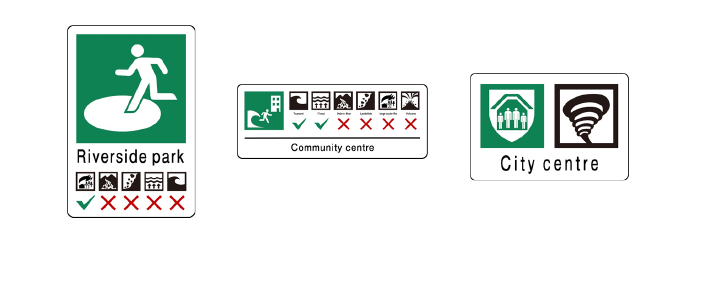
The natural disaster safety way guidance system must provide warning signs, evacuation information signs, evacuation guidance signs and evacuation area signs without interruption based on the concept of seamless design and according to the actual estimated condition.
4.Examples of installations of natural disaster safety way guidance system Combined display of graphical symbols (for warnings, types of disasters, evacuation areas and shelters) and the relevant specific names in lettering for each type of disaster. Directional arrow, distance, elevation and water height may be added.
Figure 4 Example of installations of natural disaster safety way guidance system
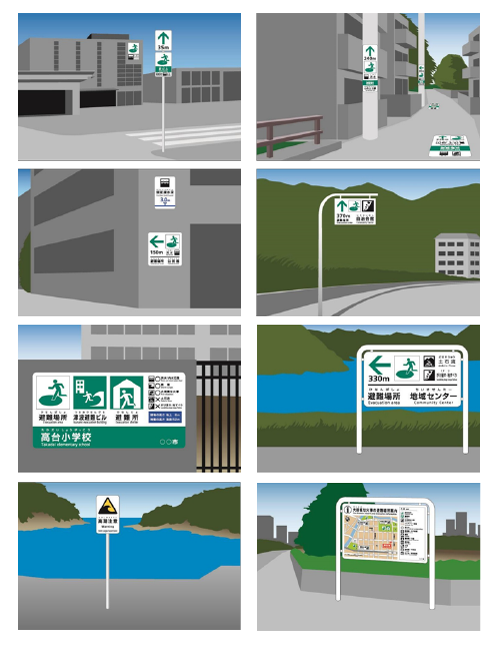
【Measures for assuring visibility in darkness of natural disaster safety way guidance system】
Signs shall be identifiable and legible under daylight and night-time conditions.
At night-time the natural light is less effective for reflective signs such that signs need to be either light emitting, such as phosphorescent signs, or be externally illuminated by a light source, such as by street lighting or integral light source. The failure of the power supply to artificial light sources also should be considered.
For phosphorescent signs, the whole surface of the sign carrier should be phosphorescent. If this is not practical, at least the graphical symbols and directional arrows should be identifiable using phosphorescent material.
The minimum requirement for the luminance decay properties of phosphorescent materials used in components of the natural disaster safety way guidance system shall be as given in Table 3 for the category of luminance classification.
< Table 2- Luminance decay classification of outdoor phosphorescent safety signs >

In order to classify luminance performance under a standard test condition, the test condition adopted consists of excitation with mean UV irradiance of 400µW/㎠ or luminance of 3,000 lx for 60 min on the surface of the test specimen at (23±2)℃.
The luminance performance of products can differ in the decay times before 720 min despite achieving the minimum value at 720 min. There can be reasons for using/selecting products with different luminance characteristics. Test values of luminance at the additional designated decay times of 60 min, 120 min and 360 min are given in the test report.
In the application of phosphorescent signs, in general, the UV irradiance in the time period before sunset is likely to be less than the test conditions such that the decay time to reach 10 mcd/㎡ or 3 mcd/㎡ would be shorter than 720 min.
b)Inspection and maintenance
Luminance of phosphorescent signs should be measured at the site of installation, and if the measurement result fails to reach the specified level, that sign should be replaced.
Maintenance should be conducted at any time as required. Inspections should be performed according to the applicable code or regulation, and in the absence of applicable code or regulation, the signs should be inspected at least once a year.
【Precautions regarding natural disaster safety way guidance system】
a) Install signs in a prominent place within the normal visual field.
b) Make signs stand out in the surrounding environment.
c) Select locations such that the signs themselves do not pose a risk to the environment.
d) Make sure that the signs are clearly visible and legible. Also check the visibility at nighttime. If possible, an open space should be maintained in front of a sign. This ensures that no obstructions exist for those without eyeglasses or those with impaired vision who may approach the sign to read it closely.
e) Ground surface signs can be effective as supplementary signs at a blind corner, not far-sighted places or places where vertical installation is not possible. It is necessary to check the performance and effect of the phosphorescent materials in a snowy region or in a place where rainwater can change the sign installation environment significantly since it may not fully exhibit the expected performance. The sites of installation and other matters related to the natural disaster safety way guidance system shall be decided by the relevant local government.
For phosphorescent materials, where practical, select locations where the signs would be exposed to direct sunlight, preferably in the afternoon. Phosphorescent signs should not be placed in locations in permanent shadow.
- Durability of the base plate materials
- Durability of displays
- Colour selection and lightfastness
- Resistance to abrasion caused by the flow of people and repeated cleaning
- Water proofness
- Resistance to corrosion such as caused by seawater spray
- Resistance to pasting of paper or flyers and writing of graffiti
- Flame resistance
- Types of accessories and their suitability
- Resistance to wind pressure
- protection against excessive UV and moisture.
Signs to be installed shall preferably be suitable for the expected environmental conditions of the site of installation. Installers and designers of signs shall preferably confirm the above points by checking the materials certificates, requesting approval of materials and other documents submitted by the supplier.
Should you require any further information, please do not hesitate to contact us.
② In order to guide people to the evacuation sites or shelters when natural disasters occur, it is essential not to make them lose their ways. So, guidance signs must be installed at appropriate intervals and without interruption on the way to the evacuation site.
③ When a disaster occurs at night and the lifeline is interrupted and the normal power supply is lost, how to reach the evacuation site in total darkness is an important issue, so measures against darkness were recommended.
1. Scope
This standard specifies the principles governing the design and application of signs and plans used to create a natural disaster safety way guidance system, which helps people evacuate to safety areas or shelters in case of natural disasters such as landslides, debris flow, steep slopes, tsunamis, tornadoes, floods, large-scale fire, and volcanic eruptions.
2. Purpose of the safety way guidance system
The natural disaster safety way guidance system is necessary to warn people in areas likely to be affected by a disaster when it occurs and help them take safety action quickly according to the type of disaster. The objective of the natural disaster safety way guidance system is to display information about the hazards of possible natural disasters in vulnerable regions, warn the people living in the area that is affected by a disaster when it occurs, and guide them to evacuate quickly.
3. Signs used in natural disaster safety way guidance system
a) Safety signs
The safety sign components of natural disaster safety way guidance signs shall be registered safety signs from ISO 7010. Signs used in natural disaster safety way guidance systems are shown in Table 1.

b) Directional supplementary arrow signs
Arrows in direction signs shall be used in conjunction with safety signs to indicate the direction of movement a person should take to reach the indicated destination. The format of the direction arrow shall be arrow type D from ISO 3864-3.
c) Suitability marking
It is necessary to indicate the type of disasters which the places of refuge are appropriate. Place of refuge signs ensure anyone who happens to be visiting and unfamiliar with the area is able to identify their suitability or unsuitability properly. This is because the construction and location for place of refuge may only be appropriate for particular natural disasters.In the place of refuge signs and evacuation route signs, the appropriate supplementary symbols which are given in Table 1 should be used to indicate the suitable and not suitable natural disasters for that place of refuge.

d) Evacuation route sign
Show the direction and the distance to the nearest suitable place of refuge. Provide information concerning evacuation direction and distance to the suitable place of refuge.
e)Place of refuge sign
Show the safe area(protection shelter, tsunami evacuation building, outdoor refuge area and tsunami evacuation area). Provide information in prominent positions at the designated locations for place of refuge concerning suitability for use when a particular natural disaster occurs.
The natural disaster safety way guidance system must provide warning signs, evacuation information signs, evacuation guidance signs and evacuation area signs without interruption based on the concept of seamless design and according to the actual estimated condition.
4.Examples of installations of natural disaster safety way guidance system Combined display of graphical symbols (for warnings, types of disasters, evacuation areas and shelters) and the relevant specific names in lettering for each type of disaster. Directional arrow, distance, elevation and water height may be added.

【Measures for assuring visibility in darkness of natural disaster safety way guidance system】
1.Measures for ensuring visibility in darkness
This standard is intended to be used for the safety way guidance for the outdoors.Signs shall be identifiable and legible under daylight and night-time conditions.
At night-time the natural light is less effective for reflective signs such that signs need to be either light emitting, such as phosphorescent signs, or be externally illuminated by a light source, such as by street lighting or integral light source. The failure of the power supply to artificial light sources also should be considered.
2.Specifications of Phosphorescent materials used in measures for assuring visibility in darkness
a)Phosphorescence luminance of phosphorescent materialsFor phosphorescent signs, the whole surface of the sign carrier should be phosphorescent. If this is not practical, at least the graphical symbols and directional arrows should be identifiable using phosphorescent material.
The minimum requirement for the luminance decay properties of phosphorescent materials used in components of the natural disaster safety way guidance system shall be as given in Table 3 for the category of luminance classification.

In order to classify luminance performance under a standard test condition, the test condition adopted consists of excitation with mean UV irradiance of 400µW/㎠ or luminance of 3,000 lx for 60 min on the surface of the test specimen at (23±2)℃.
The luminance performance of products can differ in the decay times before 720 min despite achieving the minimum value at 720 min. There can be reasons for using/selecting products with different luminance characteristics. Test values of luminance at the additional designated decay times of 60 min, 120 min and 360 min are given in the test report.
In the application of phosphorescent signs, in general, the UV irradiance in the time period before sunset is likely to be less than the test conditions such that the decay time to reach 10 mcd/㎡ or 3 mcd/㎡ would be shorter than 720 min.
b)Inspection and maintenance
Luminance of phosphorescent signs should be measured at the site of installation, and if the measurement result fails to reach the specified level, that sign should be replaced.
Maintenance should be conducted at any time as required. Inspections should be performed according to the applicable code or regulation, and in the absence of applicable code or regulation, the signs should be inspected at least once a year.
【Precautions regarding natural disaster safety way guidance system】
1.General requirements
The following principles shall preferably be applied when installing natural disaster evacuation guidance sign systems:a) Install signs in a prominent place within the normal visual field.
b) Make signs stand out in the surrounding environment.
c) Select locations such that the signs themselves do not pose a risk to the environment.
d) Make sure that the signs are clearly visible and legible. Also check the visibility at nighttime. If possible, an open space should be maintained in front of a sign. This ensures that no obstructions exist for those without eyeglasses or those with impaired vision who may approach the sign to read it closely.
e) Ground surface signs can be effective as supplementary signs at a blind corner, not far-sighted places or places where vertical installation is not possible. It is necessary to check the performance and effect of the phosphorescent materials in a snowy region or in a place where rainwater can change the sign installation environment significantly since it may not fully exhibit the expected performance. The sites of installation and other matters related to the natural disaster safety way guidance system shall be decided by the relevant local government.
2.Installation Interval
Interval is an important factor for deploying natural disaster safety way guidance signs. In order to guide people continuously, all respective signs should be installed seamlessly from the hazardous zone to the final evacuation facility at appropriate intervals. In particular, at an intersection where the road branches off into different directions, the directional arrow indicating the direction of evacuation to designated place of refuge should be identifiable from safe positions. Evacuees may feel uneasy if the interval between signs becomes longer. The sign interval should be carefully studied on site to check the next sign would be identified at the place where one is now at.For phosphorescent materials, where practical, select locations where the signs would be exposed to direct sunlight, preferably in the afternoon. Phosphorescent signs should not be placed in locations in permanent shadow.
3.Durability and suitability
The natural disaster evacuation guidance sign system should preferably be selected considering the environment of the installation site. The following factors should also be considered:- Durability of the base plate materials
- Durability of displays
- Colour selection and lightfastness
- Resistance to abrasion caused by the flow of people and repeated cleaning
- Water proofness
- Resistance to corrosion such as caused by seawater spray
- Resistance to pasting of paper or flyers and writing of graffiti
- Flame resistance
- Types of accessories and their suitability
- Resistance to wind pressure
- protection against excessive UV and moisture.
Signs to be installed shall preferably be suitable for the expected environmental conditions of the site of installation. Installers and designers of signs shall preferably confirm the above points by checking the materials certificates, requesting approval of materials and other documents submitted by the supplier.
Should you require any further information, please do not hesitate to contact us.